

Adolescence. Definition, Characteristics, & Stages. Adolescence, transitional phase of growth and development between childhood and adulthood.

The World Health Organization (WHO) defines an adolescent as any person between ages 10 and 19. This age range falls within WHO’s definition of young people, which refers to individuals between ages 10 and 24. Top Questions How is adolescence defined? Adolescence is the transitional phase of growth and development between childhood and adulthood. The Three Stages of Adolescence. Adolescent Development. Overview During adolescence, young people experience many changes as they transition from childhood into young adulthood.
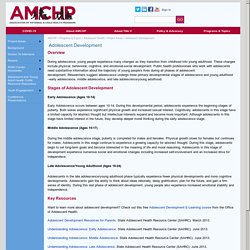
These changes include physical, behavioral, cognitive, and emotional-social development. Public health professionals who work with adolescents need substantive information about the trajectory of young people's lives during all phases of adolescent development. Stages of Adolescence. By: Brittany Allen, MD, FAAP & Helen Waterman, DO Adolescence is the period of transition between childhood and adulthood.
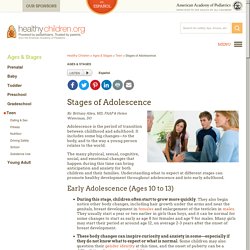
It includes some big changes—to the body, and to the way a young person relates to the world. The many physical, sexual, cognitive, social, and emotional changes that happen during this time can bring anticipation and anxiety for both children and their families. Understanding what to expect at different stages can promote healthy development throughout adolescence and into early adulthood. Early Adolescence (Ages 10 to 13) Identity. Identity. One of the most enduring theories of development was proposed by psychologist Erik Erikson.
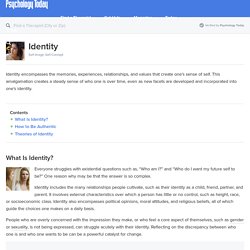
Erikson divided the lifecycle into eight stages that each contained a conflict, with the resolution of those conflicts leading to the development of personality. The conflict that occurs during adolescence, Erikson believed, is “identity versus role confusion.” Positive Identity as a Positive Youth Development Construct: A Conceptual Review. Identity is a core construct in psychology because it refers to how a person addresses issues dealing with who that person is.
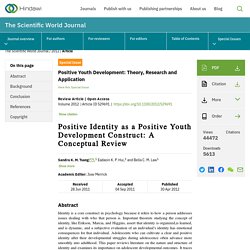
Important theorists studying the concept of identity, like Erikson, Marcia, and Higgins, assert that identity is organized,is learned, and is dynamic, and a subjective evaluation of an individual’s identity has emotional consequences for that individual. Adolescents who can cultivate a clear and positive identity after their developmental struggles during adolescence often advance more smoothly into adulthood. This paper reviews literature on the nature and structure of identity and examines its importance on adolescent developmental outcomes. What Is Self-Concept and How Does It Form? Self-concept is the image that we have of ourselves.
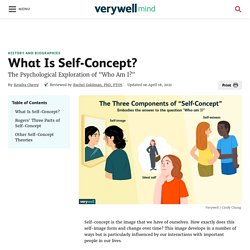
How exactly does this self-image form and change over time? This image develops in a number of ways but is particularly influenced by our interactions with important people in our lives. What Is Self-Concept? Self-concept is how you perceive your behavior, abilities, and unique characteristics.1 For example, beliefs such as "I am a good friend" or "I am a kind person" are part of an overall self-concept. Self-concept tends to be more malleable when you're younger and still going through the process of self-discovery and identity formation. What Is Self-Esteem? Having healthy self-esteem can influence your motivation, your mental well-being, and your overall quality of life.

However, having self-esteem that is either too high or too low can be problematic. Better understanding what your unique level of self-esteem is can help you strike a balance that is just right for you. What Is Self-Esteem? In psychology, the term self-esteem is used to describe a person's overall subjective sense of personal worth or value. Identity Crisis: Symptoms, Causes, Treatments, and Coping. What Is an Identity Crisis?
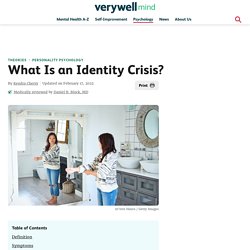
An identity crisis is a developmental event that involves a person questioning their sense of self or place in the world. The concept originates in the work of developmental psychologist Erik Erikson, who believed that the formation of identity was one of the most important conflicts that people face. According to Erikson, an identity crisis is a time of intensive analysis and exploration of different ways of looking at oneself.
While developing a sense of identity is an important part of the teenage years, Erikson did not believe that the formation and growth of identity were confined to adolescence only. Erikson's Psychosocial Development Theory. Erik Erikson's Stages of Psychosocial Development. Erik Erikson was an ego psychologist who developed one of the most popular and influential theories of development. While his theory was impacted by psychoanalyst Sigmund Freud's work, Erikson's theory centered on psychosocial development rather than psychosexual development. The stages that make up his theory are as follows:1. Psychosocial Stages. Erik Erikson's Stages of Psychosocial Development By Dr.
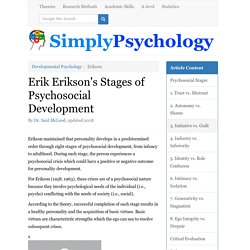
Saul McLeod, updated 2018. Identity vs. Role Confusion in Erikson's Theory. Identity versus confusion is the fifth stage of ego according to psychologist Erik Erikson's theory of psychosocial development.
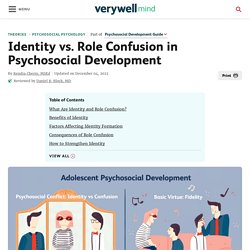
This stage occurs during adolescence between the ages of approximately 12 and 18. During this stage, adolescents explore their independence and develop a sense of self. According to Erikson, people progress through a series of stages as they grow and change throughout life. During each stage, people face a developmental conflict that must be resolved to successfully develop the primary virtue of that stage. Psychosocial Development - an overview. 7.04.3.2 Psychological Aspects Modern developmental psychology emphasizes that development is not limited to childhood or youth but continues over the life course. This life-span perspective views development as a product of an interplay between biological, cultural, and psychological influences, that is, individuals interact with their environment continuously over the life course (Baltes, 1987; Baltes, Reese, & Lipsitt, 1980).
Cultural influences change considerably with time. This fact can be illustrated by a closer look at elderly subjects who were investigated, at age 70 in 1980. These subjects were born in 1910. Marcia's Identity Statuses. 6.3 Adolescence: Developing Independence and Identity – Introduction to Psychology. Learning Objectives Summarize the physical and cognitive changes that occur for boys and girls during adolescence.Explain how adolescents develop a sense of morality and of self-identity. Adolescence is defined as the years between the onset of puberty and the beginning of adulthood.
In the past, when people were likely to marry in their early 20s or younger, this period might have lasted only 10 years or less—starting roughly between ages 12 and 13 and ending by age 20, at which time the child got a job or went to work on the family farm, married, and started his or her own family. 15.2: James Marcia – Theory of Identity Development - Social Sci LibreTexts. One approach to assessing identity development was proposed by James Marcia. In his approach, adolescents are asking questions regarding their exploration of and commitment to issues related to occupation, politics, religion, and sexual behavior.
Studies assessing how teens pass through Marcia’s stages show that although most teens eventually succeed in developing a stable identity, the path to it is not always easy and there are many routes that can be taken. Some teens may simply adopt the beliefs of their parents or the first role that is offered to them, perhaps at the expense of searching for other more promising possibilities (foreclosure status). Identity Status - an overview. Empirical Evidence Until recently, few studies addressed the identity–creativity question. First, studying high school and college samples, Waterman and colleagues found that poetry writing—but not journal writing—was significantly related to identity achievement (Waterman & Archer, 1979; Waterman, Kohutis, & Pulone, 1977). Moreover, in longitudinal research, the dimension of “cultural sophistication” (including artistic interests) predicted later identity achievement (Waterman & Goldman, 1976; Waterman & Waterman, 1971).
Also conducting a longitudinal study, Helson and Pals (2000) studied graduates of a liberal arts college for women when participants were in their early 20s and again in their early 40s. These authors correlated California Q-sort personality descriptions with a prototype of the identity-achieved person (Mallory, 1989); each participant’s similarity to this prototype was the measure of identity achievement. Why adolescents strive to forge a sense of identity? Why Is Teen Identity Development Important? Identity Development. Identity Development Theory. How adolescents strive to forge a sense of identity? Your Teen's Search for Identity. Adolescent Identity Development: What to Expect in Teens. How Do Teens Form Their Identity? Teen identity: Figuring out who you are. Factors affecting identity formation.
What Factors Contribute to the Identity Development of Internatio. INDIVIDUAL AND INSTITUTIONAL FACTORS AFFECTING IDENTITY AMONG MINORITY AND FEMALE SCIENCE STUDENTS. Global Processes as a Factor of Influence on Identity Development of Russian Citizens. How parents can help their adolescents in this stage of life? Social Media Use Subgroups Differentially Predict Psychosocial Well-Being During Early Adolescence. Adolescence (15-17 years old) Helping Your Child through Early Adolescence. Parenting: Preparing For Adolescence. Tips for Communicating With Your Teen. 10 Tips for Parenting Tweens. Six Ways to Build Your Teen's Identity - Focus on the Family.